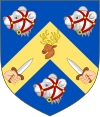Clan Mackay
| Clan Mackay | |||
|---|---|---|---|
| Mac Aoidh/Clann Mhic Aoidh or Sìol Mhorgain | |||

Crest: A dagger held erect
|
|||
| Motto | Manu forti (With a strong hand) | ||
| War cry | Bratach Bhan Chlann Aoidh | ||
| Profile | |||
| Region | Highland | ||
| District | Strathnaver | ||
| Plant badge | Bulrush | ||
| Pipe music | Bratach Bhan Chlann Aoidh (The White Banner of MacKay) | ||
| Chief | |||
 |
|||
| Æneas Simon Mackay | |||
| 15th Lord Reay | |||
| Historic seat | Castle Varrich | ||
|
|||
|
|||
|
|||
|
|||
Clan Mackay (Scottish Gaelic: Clann Mhic Aoidh [ˈkʰl̪ˠãũn̪ˠ vĩçˈkʲɤj]) is an ancient and once-powerful Scottish clan from the far North of the Scottish Highlands, but with roots in the old kingdom of Moray. They supported Robert the Bruce during the Wars of Scottish Independence in the 14th century. In the centuries that followed they were anti-Jacobite. The territory of the Clan Mackay consisted of the parishes of Farr, Tongue, Durness and Eddrachillis, and was known as Strathnaver, in the north-west of the county of Sutherland. However, it was not until 1829 that Strathnaver was considered part of Sutherland when the chief sold his lands to the Earls of Sutherland and the Highland Clearances then had dire consequences for the clan. In the 17th century the Mackay chief's territory had extended to the east to include the parish of Reay in the west of the neighbouring county of Caithness. The chief of the clan is Lord Reay and the lands of Strathnaver later became known as the Reay Country.
Historian Angus Mackay in his "Book of Mackay" (1906) compares two different genealogies of the early chiefs of the Clan Mackay. The first is by Sir Robert Gordon, a 17th-century historian and the second by Alexander Mackay of Blackcastle, an 18th- to 19th-century historian who had access to the charters and historical documents of the Mackay chief's family. Both genealogies have similarities but there are also significant differences given for the ancestry of the Mackay chiefs. Gordon's genealogy also claims that the chiefs of the Clan Mackay shared a common ancestor with both the chiefs of the Clan Forbes and chiefs of Clan Farquharson. Historian Angus Mackay gives evidence that explains that Gordon's theory of the connection to the Forbeses was due to an extremely strong alliance between the two families that began during the 16th century in a long feud with the Gordon family. The Blackcastle MS shows that the Mackay chiefs were related to the Farquharsons but gives a different connection to that given by Gordon. Angus Mackay analyses what evidence is available to support each of the two genealogies and concludes that the one given in Alexander Mackay's Blackcastle Manuscript is by far the most accurate.
...
Wikipedia
